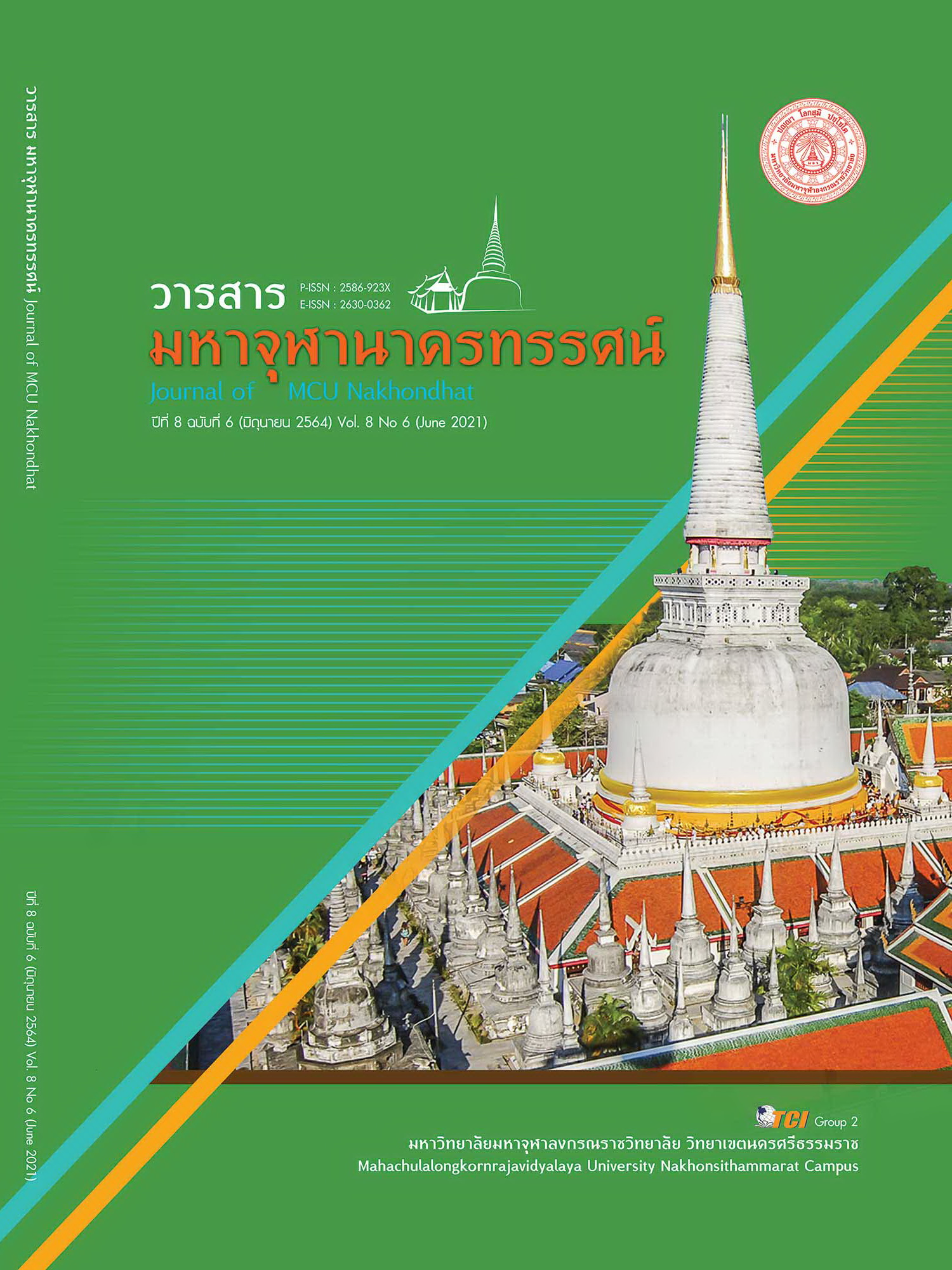BUILDING RELATIONSHIP BETWEEN COMMUNITY AND TEMPLE ACCORDING TO SANGKHAHAWATTHU 4
Main Article Content
Abstract
This academic article This is a study of building relationships between communities and temples. According to the principle of Sangkhahawatthu 4 . Adapted to create a relationship between the community and the temple. Happily together The community is a critical component of the measure that is constantly maintained. And the temple had an influence and a huge role in the way of life of the community because the community and the temple are the spiritual centers Moral And the community used the temple to perform various rituals. In addition to being respected by the villagers in the community It is also considered a place where the community has come to take advantage of the peace of self and the community as well. Building a relationship between the community and the temple to have a good relationship with each other. Building relationship between community and temple According to the principle of Sangkhahawatthu 4, in the present day, most communities or most teenagers do not have time to enter the temple.Therefore, the community and the temple are very distant, therefore, the relationship between the community and the temple should be established. By giving the teachings of Buddhism as a principle for building relationships By using the Sangkhahawatthu 4 principles of Sangha, such as Dharma, which is the location of aiding each other Including 1) giving things to people who should give 2) Piy waca and negotiate with lovely words Sweet, sweet, 3) Xạt th criya, behaviors for the benefit of others, and 4) Samanatta is consistent. Not self-centered the main Sangkhha Object 4 is to create a relationship between the community and the temple. For the community to be able to understand and care about temples to be merit in a good way
Article Details
References
พระครูบุญญสารโสภิต (เหล็กอยู่). (2555). การศึกษาหลักสังคหวัตถุ 4 ที่หัตถกคหบดีนาไปใช้ในพระสุตตันตปิฎก. ใน วิทยานิพนธ์พุทธศาสตรมหาบัณฑิต สาขาพระพุทธศาสนา. มหาวิทยาลัยมหาจุฬาลงกรณราชวิทยาลัย.
พระครูอาทรปริยัติยานุกิจ (สุจิตฺโต/เพียรสองชั้น). (2555). การประยุกต์ใช้หลักสังคหวัตถุ 4 ในการบริหารงานบุคคลในโรงเรียนพระปริยัติธรรมแผนกสามัญศึกษาในอาเภอสุวรรณภูมิจังหวัดร้อยเอ็ด. ใน วิทยานิพนธ์พุทธศาสตรมหาบัณฑิต สาขาพระพุทธศาสนา. มหาวิทยาลัยมหาจุฬาลงกรณราชวิทยาลัย.
พระเดชา กิตฺติโก (โชติธราธรรม). (2556). การบริหารงานบุคคลตามหลักสังคหวัตถุ 4 ของผู้บริหารโรงเรียนธรรมภิรักษ์ เขตบางพลัด กรุงเทพมหานคร. ใน วิทยานิพนธ์พุทธศาสตรมหาบัณฑิต สาขาพระพุทธศาสนา. มหาวิทยาลัยมหาจุฬาลงกรณราชวิทยาลัย.
พระธรรมปิฎก (ป.อ. ปยุตฺโต). (2546). พจนานุกรมพุทธศาสตร์ ฉบับประมวลธรรม. (พิมพ์ครั้งที่ 12). กรุงเทพมหานคร: มหาวิทยาลัยมหาจุฬาลงกรณราชวิทยาลัย.
. (2550). ธรรมนูญชีวิต (พิมพ์ครั้งที่ 4). กรุงเทพมหานคร: โรงพิมพ์สำนักงานพระพุทธศาสนาแห่งชาติ.
พระมหาพีระพงษ์ พยัคกาฬ. (2549). ความสัมพันธ์ระหว่างวัดกับชุมชนในการจัดการการเทศน์มหาชาติของล้านนา. ใน วิทยานิพนธ์ศึกษาศาสตรมหาบัณฑิต สาขาการศึกษานอกระบบ. มหาวิทยาลัยเชียงใหม่.
พระมหาสุวิทย์ วิชฺเชสโก. (2537). ทานก้าวแรกแห่งการพัฒนาคุณภาพชีวิต. กรุงเทพมหานคร: บริษัทฟองคูณ โทขันธ์.
สมเด็จพระอริยวงศาคตญาณ (วาศน์ วาสโน). (2528). สังคหวัตถุ 4. กรุงเทพมหานคร: โรงพิมพ์มหามกุฎราชวิทยาลัย.
สานิตย์หนูนิล และกนกวรา พวงประยงค์. (2562). ปัจจัยที่มีผลต่อรูปแบบการดำเนินชีวิตของคนรุ่นใหม่ในชนบทไทย. วารสารพัฒนาสังคม, 21(2), 1-20.
สุทธิพงศ์ ปานเพ็ชร์. (2550). การประยุกต์หลักพุทธธรรมกับวิถีชีวิตชุมชน. ใน รายงานการวิจัยอิสระ. มหาวิทยาลัยธุรกิจบัณฑิตย์.
สุพิศวง ธรรมพันทา. (2540). มนุษย์กับสังคม. กรุงเทพมหานคร: สำนักพิมพ์ ดี.ดี.บุ๊คสโตร์.


